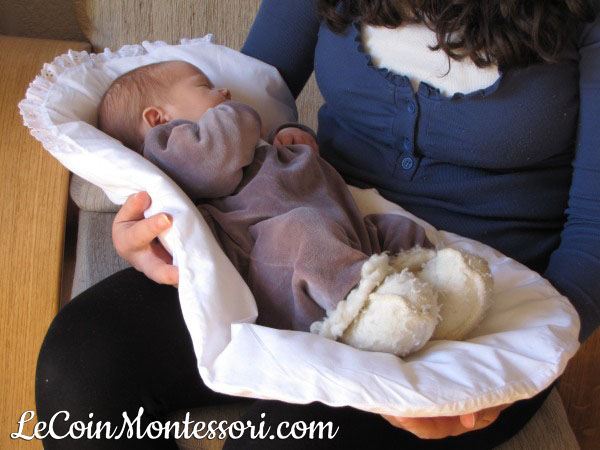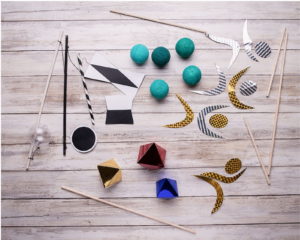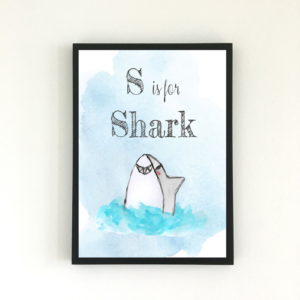Are you dreaming about a picture-perfect Montessori nursery? Every parent, baby and house is different, but there are some baby items that you will likely find in every Montessori baby’s work space. The list I put together below is not exhaustive but it includes the most important elements. You don’t need to rush out and buy everything from here and you might find that you already have some of these at home. Read, learn, and choose which elements are the most important for YOU.
1. A movement mat
The aim of a mat is to provide your baby with a soft, safe place to lay on, to wriggle and to move. This is a designated area that marks their space, not only for them but for the adults around them as well. It is only used for “work”, not for napping.
I would urge you not to spend money on baby or activity gyms. Any kind of soft mat/folded up blanket will be great for the purpose. You’ll find a mat a lot more versatile and will probably use it for a lot longer than you would a baby gym.
For very young babies, a fake sheepskin like on the photo below (from IKEA) is fine, but as an extra protection put a muslin under your baby. It saved me from washing my little boy’s play mat many times over, there’s enough washing to do anyway at this age! Later it’s worth swapping it for something bigger. You can fold up a blanket as well. However, when your baby starts to roll around, use something more firm that doesn’t bunch up, such as a crib mattress.

2. Horizontal Mirror
Newborn babies are inherently attracted to human faces and like gazing at them. At this point they would not recognise themselves, of course, but they can still observe their and your features.
Later, as they start moving, they can observe and track their own movements in the mirror. It also gives them an opportunity to view the whole room and see what’s happening around them. Moreover, whatever you put in front of the mirror will be doubled, this way giving objects and extra dimension.
There are a few important points to consider.
- If possible, the mirror should be in a separate area from the bed, as it stimulates instead of relaxing.
- You should get a full length mirror which you can turn sideways. This will allow your baby to see his/her whole length of their body.
- I would suggest getting plexiglass instead of real glass, as the former can better withstand banging and accidental kicking.
- Make sure that it’s securely attached to the wall.
I sometimes used it during tummy time as well. I placed it on the floor and put interesting objects on it for D to look at, such as colourful wooden building blocks.
3. Topponcino
Not many people know but topponcino was not actually designed by Montessori, she took on the idea while visiting India. Personally, I did not use one but if I had a second child I would definitely make one.
The word ‘topponcino’ means ‘small blanket’ and it is just that, a thin oval-shaped mattress that’s not much bigger than your baby. Its aim is to meet your newborns’ need to be surrounded, just like s/he was in your womb. It is always under the baby, when being held, in the bassinet, during feeding time and when somebody else takes her/him. This assures that s/he’ll always feel safe and comfortable. Use it until your little one is around 8 weeks old or when s/he grows out of it.
Pro tip: before your baby arrives, sleep with the topponcino for a couple of nights so it’s takes on your mummy smell.

If you know how to use a sewing machine then it won’t take long to make one yourself, here’s a great tutorial from Voilá Montessori.
4. Black and white contrast cards
When they are born, babies’ eyesight is poor. They can only see as far as 30 cm which is the distance of the mother’s eyes from a nursing baby’s (high five, evolution!). In addition, they are only able see the colours of black and white and shades of grey, therefore black and white contrast cards are a great way to stimulate their vision. You can find many of these online, I printed out these for my little boy. Below is a video of him observing them.
He loved staring at these high contrast cards! I put them everywhere, on the wall next to his changing mat, in front of his mirror for tummy time, I even made a book out of some bigger pictures and made a mobile out of them. It’s good to have a variety of them so you can change them every few days or when your baby is not interested any more. Here are some nice ones which are also lovely, I would even use them for baby art (read point 8.).
If you’d like to read more about how a baby’s vision develops, visit this easy-to-read website.
This website tells you more about how the research was conducted with babies (I find some of them truly ingenious!) and a fascinating read.
For more black and white resource ideas read this post.
5. Montessori mobiles in a Montessori workspace

you can find it in my Shop.
In a Montessori baby’s work space the mobiles are essential. These are designed to appropriately follow and stimulate the development of vision from birth. If you’re interested in how the mobiles follow and assist your baby’s development, read this post.
If you’d like to make them yourself but don’t have the time to start everything from scratch, I have prepared a box which includes the first four mobiles. It has all the resources and explanations you need to assemble them, including videos. If you’d like to learn more, visit my Shop.
6. Mobile holder
There are many mobile holders out there. It doesn’t need to be anything fancy. Instead of spending on a baby gym I would just get a simple wooden one. If you have the chance, get a foldable one so it’s easy to store when not in use. Also, try to get it secondhand. It’s one of those big bulky baby items that you’ll only need for a few months and will then put away.
We used the famous IKEA mobile holder (which they actually call baby gym). You can take the plastic toys it comes with out easily and place your own mobiles in it, using the holes on top. Click here if you’d like to read about the Montessori mobiles.
7. Baby books
As an ex-Montessori guide who focused on literacy, I fully believe that you can’t possibly start reading early enough. Of course, in the first few months this does not mean actual reading, it might only consist of looking at some black and white cards (see above) and talking about them. Besides, your baby loves being close to you, looking at your face and listening to your voice more than anything, so give it a go. They will spend a good few seconds starting at each photo. When they turn their head away, then you know that they are finished with that particular page.
D got a baby book as a present that I really liked, it is the one he’s reading in the video. Take a look, if you’re interested.
8. Low-hanging baby art pictures
I know that this sounds quite far-fetched. Again, it doesn’t need to be anything expensive, you can download something from the internet. As an example, pictures of animals seem to be very popular, but you can choose whatever you feel like putting on the wall, as long as it shows realistic images. These pictures are great conversation starters with your baby and are excellent for tummy time, too.

+1. The Montessori floor bed
Even though babies usually sleep in another room, their bed is an essential part of their environment. You can learn more about it in this post.
FINAL THOUGHTS
To conclude, these are the most important elements of a Montessori baby’s work space. It does not mean that you need to have all these in place. Pick and choose what suits you and your circumstances the best. I believe that you don’t need every one of the items above as long as the environment is safe and comfortable. In order to achieve a well-functioning Montessori baby’s work space, you need to observe your little one, make changes regularly so it evolves together with your baby.
Why I haven’t mentioned any of the usual baby gear? Click on the next post to read about it!
